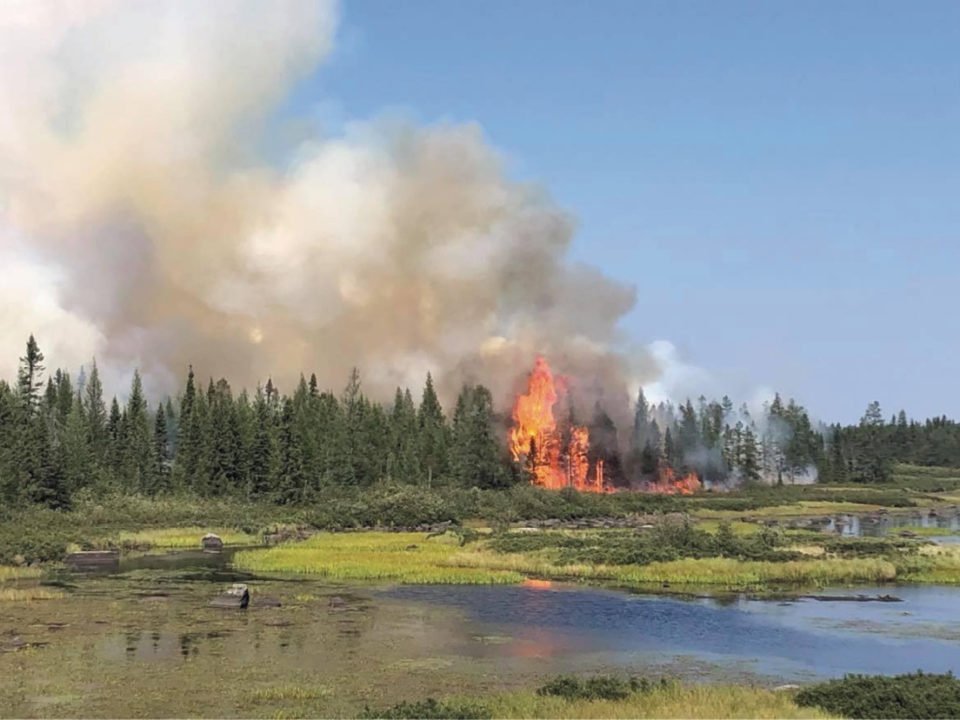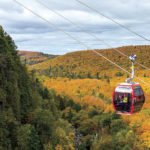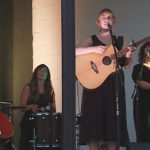On a sunny, summer afternoon a number of years ago, we were driving along a backroad when suddenly the forest surrounding us took on a rosy hue. Though lovely, a rose-tinted Northwoods means one thing: somewhere a wildfire is burning. We spotted a plume of smoke towering over the trees. The fire wasn’t far away.
Thinking the fire was likely near an isolated trout lake, I parked the truck near the access trail and started hiking. About 15 minutes later I found the fire burning along a rocky ridge beside the lake. The fire appeared to cover a couple of acres, larger than I could extinguish myself. Staying near the access trail so I could make a quick exit if necessary, I watched the fire burn. I’d never before been the first one to discover a wildfire.
The ridge was relatively open, with a mix of hazel brush and scattered trees, including standing balsams that had been killed by a native insect called spruce budworm. While the needles had fallen off, the balsams had their branches and fine twigs. I watched as the fire creeped along the ground, burning the duff and brush. Whenever it reached one of the balsams, the entire tree would ignite with a roar, as though someone touched off a barrel of gasoline.
I watched the fire burn and grow until I saw a small plane begin circling overhead. I knew then that fire had been reported. Although I belonged to the local volunteer fire department, this happened back when two-way radio coverage was very limited in the North Shore’s backcountry. I met a U.S. Forest Service crew as I walked out and hitched a ride with them back to my truck, which they had ordered my partner to move, even though she had been parked more than a half-mile away. We ended up at the staging area, where fire-fighting crews gathered prior to being deployed to the fire. Hours passed before the first firefighters hiked to the blaze. By this time, the fire had grown. As I recall, it burned a couple of hundred acres before it was extinguished a few days later.
If you live in the Northwoods for any length of time, you come to know wildfire. Fire is a natural element of the northern ecosystem and our region remains wild enough for wildfires occur. Some fires are started by lightning and some have human sources. While no one condones reckless human activity that leads to a wildfire, it must be noted that humans have started fires as long as they’ve lived on this landscape. Why? Because fire is essentially the reset button for the northern forest. A fire burns away the woods and begins a process of rebirth. Sunlight reaching the charred ground almost immediately triggers new life, a mix of ground cover, shrub and saplings that become habitat for an array of northern species that thrive in places recovering from a fire disturbance. This may range from moose browsing on young saplings to ladies in sunhats taking advantage of the wealth of blueberries that inevitably occurs after a fire.
Although wildfire is natural, so is modern humans’ fear of such fires. We can sum up why with one word: property. When Indigenous people encountered fires, they likely stayed out of the area and away from the heavy smoke until the fire was out; easy enough for nomads to do. Now we own property for our homes, businesses and more. If we are burned out by a wildfire, we have much to lose. We also have collective memories of destructive wildfires that occurred during the early logging era more than 100 years ago. The difference is those fires were in a sense unnatural, because they were fueled by the forest debris, called slash, that was left behind by early logging operations.
While a wildfire may flare up just about any time, large, landscape-level fires need the right conditions to gain momentum. Lots of fuel, drought and dry, windy weather are what it takes to build a big fire. This summer, those conditions have reached explosive levels across our Northern Wilds coverage area. We are suffering from prolonged drought and unusually hot summer weather. A periodic outbreak of spruce budworms has killed balsams and white spruce across a broad area. It is so dry that creeks are drying up. Numerous fires are burning in northeastern Minnesota and northwest Ontario, prompting the closure of the Boundary Waters and Quetico wilderness areas.
In mid-August, a lightning strike near Isabella sparked a rapidly growing blaze named the Greenwood Fire. Of the many wildfires, it was the only one with a potent mix of dead conifers for fuel and a close proximity to homes and cabins. Battling the fire became a priority for the U.S. Forest Service and other fire-fighting teams. At this writing, the Greenwood Fire remains uncontained and threatens many homes and cabins.
Everyone in the North is on edge and will remain so until our drought-stricken landscape receives substantial precipitation. For old-timers, it’s a familiar feeling. Drought and extended dry spells occur periodically. Some compare our present situation to droughts in 1976 and 1988-89. Events such as insect outbreaks and windstorm blowdowns that create massive amounts of dead wood happen periodically, too. Memories of the destructive Ham Lake Fire in 2007 and Pagami Creek Fire in 2011 are still fresh in the minds of many.
Right now, all we can do is wait. Perhaps our best hope is that a hurricane or tropical storm makes landfall somewhere along the Gulf or the southeastern coast and sends days of soaking rain our way. Someone else’s troubles ironically become our salvation. Without substantial rain, the fire danger will remain until the snow flies. If we don’t receive adequate snow over the winter, the drought conditions will resume next spring. This country runs better wet than dry. Pray not for merely rain, but a change in the precipitation pattern that restores water to the soil and swamps and bogs; the wellsprings of our boreal ecosystem. Anything less simply won’t be enough.






